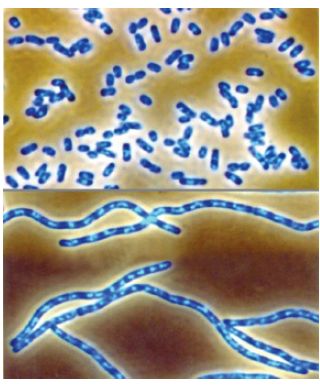


 النبات
النبات
 الحيوان
الحيوان
 الأحياء المجهرية
الأحياء المجهرية
 علم الأمراض
علم الأمراض
 التقانة الإحيائية
التقانة الإحيائية
 التقنية الحيوية المكروبية
التقنية الحيوية المكروبية
 التقنية الحياتية النانوية
التقنية الحياتية النانوية
 علم الأجنة
علم الأجنة
 الأحياء الجزيئي
الأحياء الجزيئي
 علم وظائف الأعضاء
علم وظائف الأعضاء
 الغدد
الغدد
 المضادات الحيوية
المضادات الحيوية|
Read More
Date: 28-3-2021
Date: 15-4-2021
Date: 28-10-2020
|
Mutations in Division or Segregation Affect Cell Shape
KEY CONCEPTS
- fts mutants form long filaments because the septum that divides the daughter bacteria fails to form.
- Minicells form in mutants that produce too many septa; they are small and lack DNA.
- Anucleate cells of normal size are generated by partition mutants, in which the duplicate chromosomes fail to separate.
A difficulty in isolating mutants that affect cell division is that mutations in the critical functions might be lethal and/or pleiotropic.
Most mutations in the division apparatus have been identified as conditional mutants (whose division is affected under nonpermissive conditions; typically, they are temperature sensitive). Mutations that affect cell division or chromosome segregation cause striking phenotypic changes. FIGURE 1 and FIGURE 2 illustrate the opposite consequences of failure in the division process and failure in segregation:
Long filaments form when septum formation is inhibited, but chromosome replication is unaffected. The bacteria continue to grow—and even continue to segregate their daughter chromosomes—but septa do not form. Thus, the cell consists of a very long filamentous structure, with the nucleoids (bacterial chromosomes) regularly distributed along the length of the cell.
This phenotype is displayed by fts mutants (named for temperature-sensitive filamentation), which identify a defect or multiple defects that lie in the division process itself. Minicells form when septum formation occurs too frequently or in the wrong place, with the result that one of the new daughter cells lacks a chromosome. The minicell has a rather small size and lacks DNA, but otherwise appears morphologically normal. Anucleate cells form when segregation is aberrant; like minicells, they lack a chromosome, but because septum formation is normal, their size is unaltered. This phenotype is caused by par (partition) mutants (named because they are defective in chromosome segregation).

FIGURE 1 Top panel: Wild-type cells. Bottom panel: Failure of cell division under nonpermissive temperatures generates multinucleated filaments.
Photos courtesy of Sota Hiraga, Kyoto University.

FIGURE 2. E. coli generate anucleate cells when chromosome segregation fails. Cells with chromosomes stain blue; daughter cells lacking chromosomes have no blue stain. This field shows cells of the mukB mutant; both normal and abnormal divisions can be seen.
Photo courtesy of Sota Hiraga, Kyoto University.



|
|
|
|
حمية العقل.. نظام صحي لإطالة شباب دماغك
|
|
|
|
|
|
|
إيرباص تكشف عن نموذج تجريبي من نصف طائرة ونصف هليكوبتر
|
|
|
|
|
|
ضمن اكاديمية الثقلين للتوحد واضطرابات النمو في البصرة.. شاهد بالصور أكبر مدينة افتراضية بتقنيات عالمية مخصصة للاطفال
|
|
|
|
بالصور: يقصدها الطلبة ومن مختلف الجنسيات.. أجواء مثالية لمراجعة الدروس توفرها مكتبة العتبة الحسينية التابعة لقسم الشؤون الفكرية والثقافية
|
|
|
|
تعد الأولى من نوعها.. ادارة مستشفى الثقلين للأورام في البصرة تكشف مميزات أجهزة قسم العلاج الإشعاعي
|
|
|
|
بالفيديو: يعد من المشاريع العملاقة والمهمة.. تعرف على الأسباب التي دعت العتبة الحسينية لافتتاح اكاديمية الثقلين للتوحد واضطرابات النمو في البصرة
|